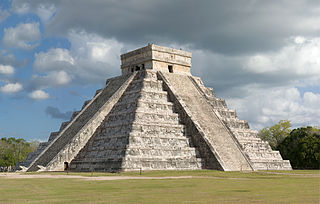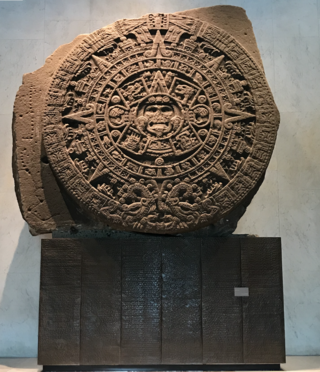Related Research Articles

In the history of the Americas, the pre-Columbian era spans from the original peopling of the Americas in the Upper Paleolithic to European colonization, which began with Christopher Columbus's voyage of 1492. Usually, the era covers the history of Indigenous cultures until significant influence by Europeans. This may have occurred decades or even centuries after Columbus for certain cultures.

The Aztec or Mexica calendar is the calendrical system used by the Aztecs as well as other Pre-Columbian peoples of central Mexico. It is one of the Mesoamerican calendars, sharing the basic structure of calendars from throughout the region.

Mary Ellen Miller is an American art historian and academician specializing in Mesoamerica and the Maya.

George Clapp Vaillant was an American anthropologist.

Vincent Joseph Scully Jr. was an American art historian who was a Sterling Professor of the History of Art in Architecture at Yale University, and the author of several books on the subject. Architect Philip Johnson once described Scully as "the most influential architectural teacher ever." His lectures at Yale were known to attract casual visitors and packed houses, and regularly received standing ovations. He was also the distinguished visiting professor in architecture at the University of Miami.

Michael Douglas Coe was an American archaeologist, anthropologist, epigrapher, and author. He is known for his research on pre-Columbian Mesoamerica, particularly the Maya, and was among the foremost Mayanists of the late twentieth century. He specialised in comparative studies of ancient tropical forest civilizations, such as those of Central America and Southeast Asia. He held the chair of Charles J. MacCurdy Professor of Anthropology, Emeritus, Yale University, and was curator emeritus of the Anthropology collection in the Peabody Museum of Natural History, where he had been curator from 1968 to 1994.

Mesoamerica is a historical region and cultural area that begins in the southern part of North America and extends to the Pacific coast of Central America, thus comprising the lands of central and southern Mexico, all of Belize, Guatemala, El Salvador, and small parts of Honduras, Nicaragua and Costa Rica. As a cultural area, Mesoamerica is defined by a mosaic of cultural traits developed and shared by its indigenous cultures.
Mesoamerica, along with Mesopotamia and China, is one of three known places in the world where writing is thought to have developed independently. Mesoamerican scripts deciphered to date are a combination of logographic and syllabic systems. They are often called hieroglyphs due to the iconic shapes of many of the glyphs, a pattern superficially similar to Egyptian hieroglyphs. Fifteen distinct writing systems have been identified in pre-Columbian Mesoamerica, many from a single inscription. The limits of archaeological dating methods make it difficult to establish which was the earliest and hence the progenitor from which the others developed. The best documented and deciphered Mesoamerican writing system, and the most widely known, is the classic Maya script. Earlier scripts with poorer and varying levels of decipherment include the Olmec hieroglyphs, the Zapotec script, and the Isthmian script, all of which date back to the 1st millennium BC. An extensive Mesoamerican literature has been conserved, partly in indigenous scripts and partly in postconquest transcriptions in the Latin script.

Maya Revival is a modern architectural style popular in the Americas during the 1920s and 1930s that drew inspiration from the architecture and iconography of pre-Columbian Mesoamerican cultures.

Karl Andreas Taube is an American Mesoamericanist, Mayanist, iconographer and ethnohistorian, known for his publications and research into the pre-Columbian cultures of Mesoamerica and the American Southwest. He is Distinguished Professor of Anthropology at the College of Humanities, Arts, and Social Sciences, University of California, Riverside. In 2008 he was named the College of Humanities, Arts, and Social Sciences distinguished lecturer.
Floyd Glenn Lounsbury was an American linguist, anthropologist and Mayanist scholar and epigrapher, best known for his work on linguistic and cultural systems of a variety of North and South American languages. Equally important were his contributions to understanding the hieroglyphs, culture and history of the Maya civilization of pre-Columbian Mesoamerica.
Latin American art is the combined artistic expression of South America, Central America, the Caribbean, and Mexico, as well as Latin Americans living in other regions.

Classic Veracruz culture refers to a cultural area in the north and central areas of the present-day Mexican state of Veracruz, a culture that existed from roughly 100 to 1000 CE, or during the Classic era.
Charles Gibson was an American ethnohistorian who wrote foundational works on the Nahua peoples of colonial Mexico and was elected President of the American Historical Association in 1977.

The Western Mexico shaft tomb tradition refers to a set of interlocked cultural traits found in the western Mexican states of Jalisco, Nayarit, and, to a lesser extent, Colima to its south, roughly dating to the period between 300 BCE and 400 CE, although there is not wide agreement on this end date. Nearly all of the artifacts associated with this shaft tomb tradition have been discovered by looters and are without provenance, making dating problematic.
Elizabeth Hill Boone is an American art historian, ethnohistorian and academic, specializing in the study of Latin American art and in particular the early colonial and pre-Columbian art, iconography and pictorial codices associated with the Mixtec, Aztec and other Mesoamerican cultures in the central Mexican region. Her extensive published research covers investigations into the nature of Aztec writing, the symbolism and structure of Aztec art and iconography and the interpretation of Mixtec and Aztec codices.

Painting in the Americas before European colonization is the Precolumbian painting traditions of the Americas. Painting was a relatively widespread, popular and diverse means of communication and expression for both religious and utilitarian purpose throughout the regions of the Western Hemisphere. During the period before and after European exploration and settlement of the Americas; including North America, Central America, South America and the islands of the Caribbean, the Bahamas, the West Indies, the Antilles, the Lesser Antilles and other island groups, indigenous native cultures produced a wide variety of visual arts, including painting on textiles, hides, rock and cave surfaces, bodies especially faces, ceramics, architectural features including interior murals, wood panels, and other available surfaces. Many of the perishable surfaces, such as woven textiles, typically have not been preserved, but Precolumbian painting on ceramics, walls, and rocks have survived more frequently.

Constantino Reyes-Valerio was a prominent Mexican scholar of pre-Columbian Mesoamerican cultures, particularly the Aztec and the Maya as well as the Colonial Art.
References
- ↑ Willey, G.R. (1998) George Alexander Kubler (26 July 1912-3 October 1996). Proceedings of the American Philosophical Society, Vol. 142, No. 4 (Dec., 1998), pp. 672-675, JSTOR 3152291
- ↑ "George Kubler" In Dictionary of Art Historians. Retrieved May 6, 2000, Web site: http://arthistorians.info/kublerg
- ↑ "George Alexander Kubler". American Academy of Arts & Sciences. Retrieved 2022-07-13.
- ↑ "APS Member History". search.amphilsoc.org. Retrieved 2022-07-13.
- ↑ "George A. Kubler" - Obituary. In Yale Bulletin & Calendar. Retrieved May 6, 2000, Web site: "Yale Bulletin & Calendar - Obituary". Archived from the original on 2007-05-18. Retrieved 2007-05-06.
- ↑ Giulio Angioni, Miseria e nobiltà della tecnica, in Fare, dire, sentire: l'identico e il diverso nelle culture, Il Maestrale 2011, pp. 71-76
- ↑ Wood, P. (2006). Reality Check. In Oxford Art Journal, 29(2), pp. 291-296.